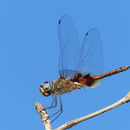fi
nimet breadcrumb-navigoinnissa


Tramea basilaris,[2] also known as the keyhole glider, red marsh trotter,[3][4] or wheeling glider, is a species of dragonfly in the family Libellulidae.[1] It is found throughout most of Africa, Arabia and in Asia.[5] Capable of very long migration and nomadic flight, it reached Europe once, being recorded (a pair) at the island of Linosa, Sicily (Italy) in 2016 (Viganò et al. 2017). Similarly, this species is able to use the trade winds to reach the Caribbean and South Americas, where it was caught in Suriname, "Guadeloupe" and "martinique" (Meurgey and Picard 2011).[1]
It is a medium-sized red dragonfly with extremely long anal appendages. It can be distinguished from other species of this genus by the two brownish black hind-wing patch surrounded by a golden yellow areola in the base. Female is similar to male; but yellowish in color.[6]
This species is found at pools, ponds, marshes, lakes and water tanks. Typical reproducing habitats are grassy marshes and ponds, but this species may be found anywhere during migrations. They are seen in tireless soaring flight in sunny days, sometimes in conspecific groups or in mixed groups of other soaring dragonflies like Pantala flavescens or Hydrobasileus croceus. It perches on exposed twigs; sometimes with the abdomen held downwards to balance in wind.[6][7][3][4]
Tramea basilaris, also known as the keyhole glider, red marsh trotter, or wheeling glider, is a species of dragonfly in the family Libellulidae. It is found throughout most of Africa, Arabia and in Asia. Capable of very long migration and nomadic flight, it reached Europe once, being recorded (a pair) at the island of Linosa, Sicily (Italy) in 2016 (Viganò et al. 2017). Similarly, this species is able to use the trade winds to reach the Caribbean and South Americas, where it was caught in Suriname, "Guadeloupe" and "martinique" (Meurgey and Picard 2011).
De gevlekte zwerver (Tramea basilaris) is een libellensoort uit de familie van de korenbouten (Libellulidae), onderorde echte libellen (Anisoptera).[2]
De soort staat op de Rode Lijst van de IUCN als niet bedreigd, beoordelingsjaar 2007.[1]
De wetenschappelijke naam Tramea basilaris is voor het eerst geldig gepubliceerd in 1805 door Palisot de Beauvois.
Bronnen, noten en/of referentiesTramea basilaris – gatunek ważki z rodzaju Tramea należącego do rodziny ważkowatych.
Imago lata od grudnia do końca maja. Długość ciała 45–49 mm. Rozpiętość skrzydeł 38–39 mm. Występuje na terenie Afryki.
Tramea basilaris – gatunek ważki z rodzaju Tramea należącego do rodziny ważkowatych.
Imago lata od grudnia do końca maja. Długość ciała 45–49 mm. Rozpiętość skrzydeł 38–39 mm. Występuje na terenie Afryki.
Tramea basilaris é uma espécie de libelinha da família Libellulidae.
Pode ser encontrada nos seguintes países: Angola, Benin, Botswana, Burkina Faso, Camarões, República Centro-Africana, Chade, Comores, República do Congo, República Democrática do Congo, Costa do Marfim, Guiné Equatorial, Etiópia, Gâmbia, Gana, Quénia, Libéria, Madagáscar, Malawi, Mali, Mauritânia, Maurícia, Moçambique, Namíbia, Níger, Nigéria, São Tomé e Príncipe, Senegal, Serra Leoa, Somália, Tanzânia, Togo, Uganda, Zâmbia, Zimbabwe e possivelmente em Burundi.[1]
Os seus habitats naturais são: florestas subtropicais ou tropicais húmidas de baixa altitude, matagal árido tropical ou subtropical, matagal húmido tropical ou subtropical, áreas húmidas dominadas por vegetação arbustiva, pântanos, lagos de água doce, lagos intermitentes de água doce, marismas de água doce e marismas intermitentes de água doce.[1]
Tramea basilaris é uma espécie de libelinha da família Libellulidae.
Pode ser encontrada nos seguintes países: Angola, Benin, Botswana, Burkina Faso, Camarões, República Centro-Africana, Chade, Comores, República do Congo, República Democrática do Congo, Costa do Marfim, Guiné Equatorial, Etiópia, Gâmbia, Gana, Quénia, Libéria, Madagáscar, Malawi, Mali, Mauritânia, Maurícia, Moçambique, Namíbia, Níger, Nigéria, São Tomé e Príncipe, Senegal, Serra Leoa, Somália, Tanzânia, Togo, Uganda, Zâmbia, Zimbabwe e possivelmente em Burundi.
Os seus habitats naturais são: florestas subtropicais ou tropicais húmidas de baixa altitude, matagal árido tropical ou subtropical, matagal húmido tropical ou subtropical, áreas húmidas dominadas por vegetação arbustiva, pântanos, lagos de água doce, lagos intermitentes de água doce, marismas de água doce e marismas intermitentes de água doce.
Tramea basilaris là một loài chuồn chuồn ngô thuộc họ Libellulidae. Nó được tìm thấy ở Angola, Bénin, Botswana, Burkina Faso, Cameroon, Cộng hòa Trung Phi, Tchad, Comoros, Cộng hòa Congo, Cộng hòa Dân chủ Congo, Bờ Biển Ngà, Guinea Xích Đạo, Ethiopia, Gambia, Ghana, Kenya, Liberia, Madagascar, Malawi, Mali, Mauritanie, Mauritius, Mozambique, Namibia, Niger, Nigeria, São Tomé và Príncipe, Senegal, Sierra Leone, Somalia, Tanzania, Togo, Uganda, Zambia, Zimbabwe và có thể có ở Burundi và ở châu Á (Ấn Độ). Các môi trường sống tự nhiên của chúng là rừng ẩm đất thấp nhiệt đới hoặc cận nhiệt đới, vùng đất có cây bụi nhiệt đới hoặc cận nhiệt đới, vùng cây bụi ẩm khu vực nhiệt đới hoặc cận nhiệt đới, đất ngập nước với cây bụi là chủ yếu, đầm lầy, hồ nước ngọt, hồ nước ngọt có nước theo mùa, đầm nước ngọt, và đầm nước ngọt có nước theo mùa.
Tramea basilaris là một loài chuồn chuồn ngô thuộc họ Libellulidae. Nó được tìm thấy ở Angola, Bénin, Botswana, Burkina Faso, Cameroon, Cộng hòa Trung Phi, Tchad, Comoros, Cộng hòa Congo, Cộng hòa Dân chủ Congo, Bờ Biển Ngà, Guinea Xích Đạo, Ethiopia, Gambia, Ghana, Kenya, Liberia, Madagascar, Malawi, Mali, Mauritanie, Mauritius, Mozambique, Namibia, Niger, Nigeria, São Tomé và Príncipe, Senegal, Sierra Leone, Somalia, Tanzania, Togo, Uganda, Zambia, Zimbabwe và có thể có ở Burundi và ở châu Á (Ấn Độ). Các môi trường sống tự nhiên của chúng là rừng ẩm đất thấp nhiệt đới hoặc cận nhiệt đới, vùng đất có cây bụi nhiệt đới hoặc cận nhiệt đới, vùng cây bụi ẩm khu vực nhiệt đới hoặc cận nhiệt đới, đất ngập nước với cây bụi là chủ yếu, đầm lầy, hồ nước ngọt, hồ nước ngọt có nước theo mùa, đầm nước ngọt, và đầm nước ngọt có nước theo mùa.